Porfolio: Paintings
A latecomer and autodidact, my journey in art started with my contemplation of nature and the Egyptian people. I have always been fascinated by the vernacular and regarded the Egyptian desert as the repository of spaces and forms that are unadulterated and intrinsically authentic. The simple adobe houses of the villages are genuine forms that preserve the traces left by the hands of their makers on their soft modeled surfaces, Women gathering or going about their daily chores have always fascinated me. I found myself naturally drawn to local iconography while avoiding narratives and cliché representations. I focused primarily on line, form, and texture and attempted to detach them from any realistic representation, while diversifying my artistic techniques away from traditional brush and paint. I started using sand and modeling paste and the three dimensionalities of the forms were treated with textures, molding, and making indents and scratches. A lyrical contemplative serenity permeated this stage of my works.
Observing the outer physical aspects of my surroundings, which took place in this early stage, was then replaced with an inner world inquiry and an introspective journey into the depths of the earth and the inner self combining ethnic sensibility with contemporary aesthetics and intellectual concern. Seeking out the edges of things and of understanding and attempts to redefine figures, space, and time, this stage involved an anxious search for a significant and harmonious order and almost an epistemological concern in looking for aesthetic constructions by means of which form engenders meanings.
Pictorial representation during these first two periods had been a comfort zone that quickly fell short when my work became more mature, and I struggled to convey what I really wanted to communicate. I needed to channel my feelings using a freer language. Relying solely on figuration became binding and restrictive. The neatness and precision of pictorial representation did not serve my purpose anymore. It wasn’t an easy progression but it was a necessary one that came with practice, experimentations, and lots of frustrations. It wasn’t until I achieved a decent grasp on my personal abstract art vocabulary that I could feel at ease again. Abstraction introduces many ambiguities to the work and allows more of the inner self to come to the surface. It also generates a lot of self-doubt about how much restraint one is able to surrender in favor of the compositional elements generated through the medium, color, and energy of the brushstrokes.
By 2009 my works engaged deeply with abstractions inspired by nature and foliage.
Although geometrical abstractions and floral designs were traditionally extensively used by the Arabs and had often been endowed with spiritual meanings, abstraction in the Western sense as an expression of emotions, moods, and a state of mind, with references or without, was hardly practiced in the Middle East. Understanding abstraction and its subtleties requires a mind structure, knowledge of a vocabulary, and modes of expression that have not yet become current usage and so remain a “foreign language” to the majority in our part of the world, viewers and artists alike.
I do not consider that each stage of my trajectory was a rupture with the previous one, as it was never a conscious and intentional move. Each period progressed almost organically into the other through “catalyst” works in between. I always start from the premise that a painting’s primary philosophical and theoretical content is to be visibly reflected through its materiality. Every canvas becomes a new challenge as I continue to work at striking that ideal balance that defines my art. I don’t have a tailor-made solution or a one-size-fits-all drill. I address each work differently and see art as a polyphonic structure that should not necessarily follow a single line of thought. Hence, I get immersed in various mental and emotional currents simultaneously in each consecutive stage of art-making, and at every stage countless options are anticipated and numerous concurrent decisions are taken with every stroke of the brush.
My works in fact illustrate a Weltanschauung revealing a specific balance between order and chaos, between reason and sensibility, and between the real and the imaginary, they are “texts” proposing a web of references, suggesting various readings and several levels of apprehension, often ambiguous and sometimes contradictory, for works of art live from the unlimited possibilities of their interpretations.
Interaction with other artists has also been part of the journey. Taking a trip to paint in the south of Egypt with a doyenne of Egyptian women artists, the late Inji Eflatoun, was a revelation. I also made a point of attending workshops and seminars with a number of local and international artists. Furthermore, the book I published on Egyptian women artists allowed me to get closer to them and to their artistic struggle. Even though the art-making process is very much an individual endeavor, it does, however, address the community. It establishes common ground between the artist and the viewer who finds resonance with one particular form of art or another. Art seeks common references in order to create new paradigms, and it engages in emotions that reach society at large, enriching it by elevating its consciousness.








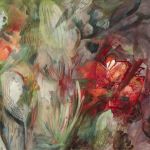
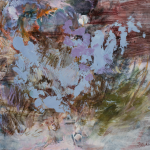

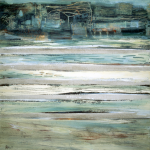
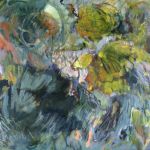
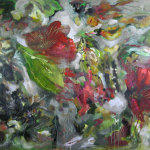
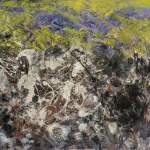
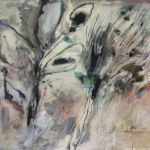
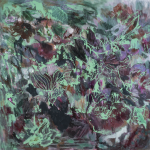
Nazli s journey with art and its evolving nature and challenges is a great example of Egyptian woman artists seeing their identity and forging a name and a much deserved place in the national and international landscape. Her article serves as a soul searching expose to this process.
Nazli’s art and article take one into the depths of her artistic gift, her inner most senses and love of Egyptian women’s beauty. I enjoyed reading her article as I have always admired her work.